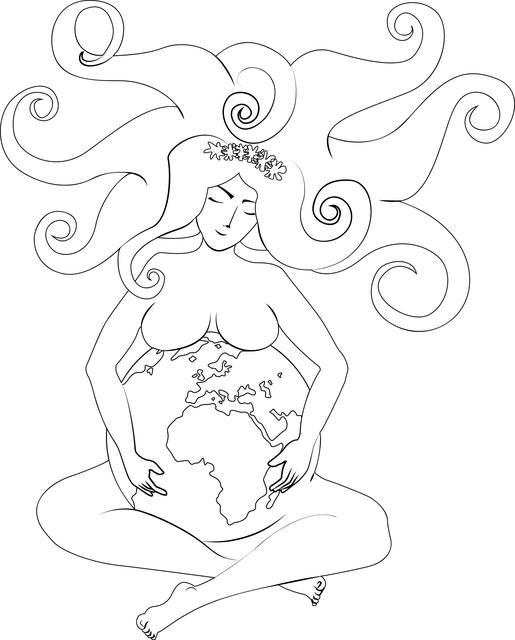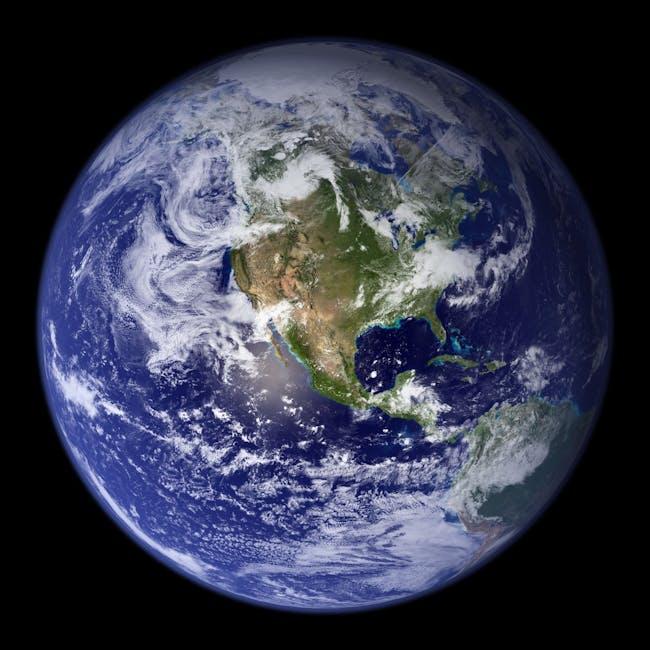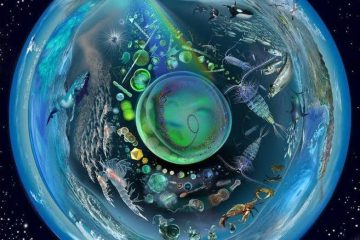Table of Contents
- Understanding the Gaia Hypothesis and Its Implications for Ecosystems
- The Interconnectedness of Life: Exploring the Synergy Between Organisms and the Environment
- How the Gaia Hypothesis Shapes Our View on Climate Change and Sustainability
- Practical Applications of the Gaia Hypothesis in Modern Environmental Science
- Future Directions: Research and Challenges in Understanding Gaias Influence on Earth Systems
- Q&A
- Concluding Remarks
Understanding the Gaia Hypothesis and Its Implications for Ecosystems
The Gaia Hypothesis proposes that Earth functions as a self-regulating system, maintained and managed by its biological and physical components. Rooted in the idea that living organisms interact with their inorganic surroundings to create a stable environment conducive to life, this theory suggests that Earth’s biosphere, geosphere, atmosphere, and hydrosphere work together in a harmonized system. For instance, plants contribute to air quality by absorbing carbon dioxide and releasing oxygen, while oceans regulate temperature and absorb carbon emissions, showcasing how interconnected life forms influence their environment.
Understanding this concept illuminates various implications for ecosystems. These include:
- Resilience: Ecosystems can adapt in response to changes, highlighting the importance of biodiversity in maintaining balance.
- Feedback Mechanisms: Positive and negative feedback loops play a crucial role in regulating climate and environmental changes.
- Interdependence: The delicate relationships among species emphasize the need for conservation efforts to protect natural habitats.
Furthermore, the Gaia Hypothesis challenges traditional perspectives by emphasizing that environmental changes are not just a result of external influences but also stem from the collective impact of living organisms. It suggests that ecosystems are far more than just collections of species; they are dynamic entities with the ability to respond to, adapt to, and sometimes mitigate the adverse effects of human actions. Embracing this holistic view encourages a more sustainable approach to managing natural resources and informs strategies aimed at fostering environmental health.

The Interconnectedness of Life: Exploring the Synergy Between Organisms and the Environment
The intricate dance of life on Earth unfolds a captivating narrative of interconnectedness, where each organism contributes to an elaborate web of existence. At the heart of this synergy lies the understanding that all living beings—plants, animals, and microorganisms—are interdependent. For instance, trees produce oxygen through photosynthesis, which is vital for respiratory processes in animals. In return, animals contribute to the nutrient cycle through waste, enriching the soil that nourishes plants. This ongoing exchange fosters a balanced ecosystem, vital for sustaining life.
From microscopic bacteria in the soil to towering redwoods, every component plays an essential role in maintaining ecological equilibrium. By examining this web, we identify key interactions, such as:
- Predation: regulates species populations, ensuring no single organism dominates.
- Pollination: facilitates plant reproduction, critical for food crops and biodiversity.
- Decomposition: returns nutrients to the soil, promoting new life growth.
Such interactions illustrate how the health of one species directly impacts the survival of others, reinforcing the idea that all life is connected. Each action reverberates through the environment, affecting weather patterns, nutrient availability, and the quality of ecosystems.
Understanding these relationships encourages us to consider how human activities disrupt this balance. Pollution, deforestation, and climate change not only harm individual species but also ripple across the ecosystem. By recognizing our role within this network, we are prompted to take action and adopt sustainable practices that preserve the delicate interplay of life. Together, we can cultivate a harmonious existence that honors the rich tapestry of the natural world.

How the Gaia Hypothesis Shapes Our View on Climate Change and Sustainability
The Gaia Hypothesis, proposed by scientist James Lovelock in the 1970s, presents a revolutionary perspective on Earth’s ecological interconnectedness. This theory posits that our planet functions as a self-regulating, complex system, where biotic and abiotic components interact to maintain conditions favorable for life. Understanding this framework alters our perception of climate change and sustainability. It emphasizes that the health of the planet is directly linked to our actions, encouraging a shift from viewing ourselves as separate entities to recognizing our integral role in Earth’s systems.
By acknowledging the Gaia Hypothesis, we become more aware of the delicate balance necessary for sustaining life. This understanding fosters a sense of responsibility towards environmental stewardship. For instance, sustainable practices gain importance as we realize that pollution, deforestation, and overconsumption disturb this balance and lead to detrimental effects on the climate. Implementing sustainable methods, such as renewable energy sources and responsible resource management, aligns with the principle that every action impacts the greater system.
Moreover, the Gaia Hypothesis compels us to collectively address climate change, promoting global initiatives and cooperation. Recognizing that Earth functions holistically allows for the development of integrated strategies that consider ecological, economic, and social dimensions. Here are some examples of initiatives inspired by this perspective:
| Initiative | Description |
|---|---|
| Carbon Footprint Reduction | Programs aimed at lowering greenhouse gas emissions through personal and corporate accountability. |
| Biodiversity Conservation | Efforts to protect ecosystems and species, emphasizing the interdependence of all life forms. |
| Sustainable Agriculture | Practices that enhance food security while preserving the environment for future generations. |

Practical Applications of the Gaia Hypothesis in Modern Environmental Science
The Gaia Hypothesis, which posits that Earth functions as a self-regulating system, finds diverse applications in modern environmental science. One prominent area is climate change research. By viewing the Earth as an interconnected organism, scientists can better understand the complex interactions between living organisms and their physical environment. This holistic approach aids in predicting climate patterns and evaluating the ecological impact of human activities. As a result, researchers can devise more effective strategies for mitigation and adaptation.
Another vital application is in biodiversity conservation. The Gaia Hypothesis emphasizes the importance of various species in maintaining ecological balance. This perspective encourages conservationists to develop strategies that support ecosystem resilience. Some key practices include:
- Restoring habitats to ensure species survival.
- Implementing sustainable land use practices.
- Integrating traditional ecological knowledge with modern science.
By considering the intricate connections among species within their ecosystems, policymakers are better equipped to create regulations that foster biodiversity and promote sustainability.
Furthermore, the philosophy behind the Gaia Hypothesis influences environmental education. By incorporating systems thinking into educational programs, future generations can develop a deeper understanding of our planet’s interconnectedness. This focus promotes awareness of personal responsibility toward the environment. Here’s a simple table outlining key educational themes based on Gaia’s principles:
| Theme | Description |
|---|---|
| Interconnectedness | The relationship between living organisms and their environments. |
| Systems Thinking | Understanding ecological systems as whole units, not just individual parts. |
| Sustainability Practices | Encouraging practices that support ongoing ecological health. |
This educational approach cultivates an advocacy for environmental stewardship, paving the way for informed actions that resonate with the core tenets of the Gaia Hypothesis.

Future Directions: Research and Challenges in Understanding Gaias Influence on Earth Systems
The Gaia hypothesis, which posits that the Earth functions as a self-regulating system, poses intriguing avenues for future research. One significant direction lies in examining the intricate links between biotic and abiotic components of Earth systems. Understanding how living organisms interact with geological and atmospheric processes could reshape our perceptions of ecological resilience and sustainability. As researchers delve deeper into these connections, they may uncover novel feedback mechanisms that ensure the stability of the planet, thus highlighting the importance of biodiversity in maintaining homeostasis.
Another compelling area of study is the impact of climate change on the Gaia framework. With rising temperatures, shifting weather patterns, and increasingly erratic climate systems, scientists face the challenge of determining how these changes might disrupt Earth’s self-regulatory functions. The interplay between human activities and natural processes will be critical in assessing potential tipping points that could thwart the balance Gaia is theorized to maintain. Investigating these dynamics could lead to practical solutions aimed at mitigating adverse effects and enhancing the planet’s resilience.
Moreover, interdisciplinary collaboration will be essential in advancing our understanding of the Gaia hypothesis. By integrating insights from fields such as biology, geology, meteorology, and even philosophy, researchers can paint a more holistic picture of Earth’s systems. Future studies might benefit from utilizing advanced technologies, such as remote sensing and big data analytics, to monitor ecosystems continuously. To facilitate this, research efforts could focus on:
- Developing comprehensive models: Crafting simulations that incorporate biological responses to environmental changes.
- Engaging citizen scientists: Harnessing community participation to gather extensive data on local ecosystems.
- Fostering global partnerships: Encouraging collaboration across borders to share knowledge and resources related to Earth dynamics.
This multifaceted approach not only promises to deepen our understanding of Gaia’s influence but also illustrates the profound interconnectedness of life and the planet. By addressing these challenges and dedicating resources to diverse research efforts, we can pave the way for sustainable solutions that honor the delicate balance that sustains our world.
Q&A
Q&A: Understanding the Gaia Hypothesis
Q1: What is the Gaia Hypothesis?
A1: The Gaia Hypothesis posits that the Earth functions as a self-regulating, complex system where living organisms interact with their inorganic surroundings to maintain conditions that are conducive to life. Proposed by scientist James Lovelock in the 1970s, this theory suggests that the biosphere, atmosphere, hydrosphere, and lithosphere are interconnected and work together to sustain life.Q2: How did the Gaia Hypothesis get its name?
A2: The hypothesis is named after Gaia, the ancient Greek goddess of the Earth. Lovelock chose this name to emphasize the idea that the Earth is a living entity composed of various systems that collaboratively foster an environment suitable for life.Q3: What are the key components of the Gaia Hypothesis?
A3: The key components of the Gaia Hypothesis include:- Interconnectedness: All living and non-living components of Earth are interconnected and influence one another.
- Homeostasis: The Earth’s systems work together to regulate conditions such as climate, chemistry, and the availability of resources, creating a stable environment.
- Self-regulation: Biological processes, like those involving plants and microorganisms, can affect the Earth’s physical environment, promoting conditions favorable for life.



0 Comments